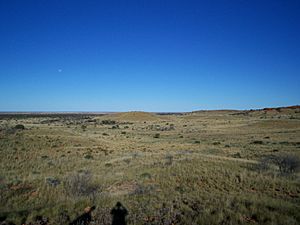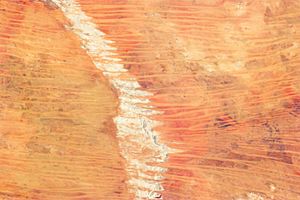Bindibu expedition facts for kids

The Bindibu expedition was a series of three trips. An anthropologist named Donald Thomson led these trips. He wanted to meet and learn from the Pintupi Indigenous Australians. These expeditions happened between 1957 and 1965.
Thomson traveled to the Great Sandy Desert and Gibson Desert. This area is known as the Western Desert. It is one of the toughest places to live in Australia. He went there to meet people who still lived as they had for thousands of years.
The Pintupi people (also called Bindibu) were among the last Aboriginal groups to meet European people. This contact happened between 1956 and 1984. Many Pintupi people still remember meeting Thomson. For some, he was the first white man they had ever seen.
In his research, Thomson focused on how the Aboriginal people hunted and gathered food. He collected many Pintupi items. These included photographs, notes, and films. These collections are now very important museum pieces.
Learning About Desert Water
Before Thomson left, the Pintupi people taught him something very important. They showed him how to find water in the desert. They even gave him a special "map" to help locate water sources. For a long time, white people wondered how Aboriginal people found water in such a dry place.
Thomson wrote about this amazing discovery:
Just before we left, the old men told me the names of more than fifty water spots. These included wells, rockholes, and claypans. This was in an area early explorers thought had almost no water. Most of these spots were still unknown to white people in 1957. On the night before we left, Tjappanongo (Tjapanangka) brought out spear-throwers. On their backs were deep, geometric designs. Sometimes with a stick or his finger, he would point to each well or rock hole. He would say its name, and I would repeat it. Each time, the old men listened closely and grunted in approval – "Eh!" – or repeated the name again. This continued until they were happy with my pronunciation. Then they moved to the next water spot.
I realized this was the most important discovery of the expedition. What Tjappanongo and the old men showed me was truly a map. It was like the designs on an Aboriginal "message" or "letter" stick. It showed the water sources of the huge area where the Bindibu hunted.

Sharing Knowledge
Besides writing for scientific journals, Thomson also wrote articles for popular magazines. One was The Australian Women's Weekly. He shared his discoveries about Australia's oldest living culture. Some people criticized him for writing in popular magazines. They thought it was not serious enough. But Thomson defended his actions. He knew that ordinary Australians were very interested in the first Australians. He wanted to show their simple, yet very clever, survival skills.
Thomson once said about the Bindibu people:
[They] have adapted themselves to that bitter environment so that they laugh deeply and grow the fattest babies in the world.
See also
- Pintupi
- Pintupi language
- Pintupi Nine
- Donald Thomson

